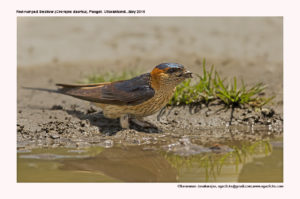Red-rumped Swallow

Red-rumped Swallow Hirundo daurica
Etymology:
- Hirundo : Latin word for Swallow
- Daurica : From Dauria, south-eastern Siberia after the Dauuri or Dagu and uri, a nomadic Mongolian tribe that inhabited the area
Vernacular names:Hindi: Masjid ababil, Kash: Phairni, Pun: Lalababil, Khasia: Midali, Guj: Kenchiababil, Kanchipunchtharodiyu, Mar: Lalbudi/ Puthyachibhingri, Ta: Tam padi, Talaiilladakuruvi, Mal: Varayankatrika, Sinh: Wehilihiniya
Distribution in India: Wide spread resident except in North West of India.
Description: Size of 16–17 cm; wt. of 19–29 g. The nominate race has glossy deep blue crown and back separated by incomplete chestnut collar, chestnut rump with fine dark streaks; wings and tail are blackish with some gloss, outer tail feathers are elongated; underparts are buffy with long dark streaks, undertail-coverts are black; underwing-coverts are creamy buff. The female has shorter tail than male. The juvenile is duller, browner above, rufous areas are paler, streaking is less distinct, wing feathers are tipped buff and has shorter tail.
Habitat: It is found in hilly country and mountains, river gorges, valleys, sea cliffs, cultivation, and human habitations, including towns. It is found from Sea-level to 3500 m. In non-breeding season, occurs in grassland, cultivation and forest clearings, and roosts in reedbeds.
Food habits: It eats flies, beetles, bugs, termites, Orthoptera and Hymenoptera. It forages usually alone, in pairs or in small groups; mixes with other swallows. It feeds both low over vegetation and high up; flight slow, with frequent gliding and soaring. It patrols cliff face or other feeding route. Sometimes feeds around human settlements and similar sites that attract insects, including markets, bazaars and shipping docks. It will perch on vegetation or ground to pick up insects, including flies from camel dung. It visits grass fires in Indian Subcontinent to look for escaping insects.
Breeding habits: They breed in Apr–Sept in Europe, Apr–Aug in HimalayasIndia and Sri Lanka, Jun–Jul in E Asia, May–Aug in Japan; in Apr–Jul in North Africa, Oct–May in West Africa, Jan and Apr–Aug in Ethiopia and Mar–Jul in East Africa. The displaying male circles, with calling, around the female, if she perches he may perch nearby and sing, sometimes displaying tail. The nest is built by both sexes, taking 1–2 weeks. The nest is enclosed, with tunnel entrance, made of mud pellets, sometimes with a little dry grass admixed, lined with mixture of white feathers, hair, plant down, leaves, pine needles or dry grass; nest of Barn swallow sometimes taken over and built up; placed above ground, usually affixed to underside of horizontal surface of natural or artificial site, like cliff, rock face, cave, culvert, bridge, drainage pipe, military bunker, bus shelter, verandah, under eaves or in stairwell or corridor of building, unoccupied farm building. The nests are reused in same and successive seasons. They lay a clutch, 2–7 eggs. The incubation is by both sexes, female doing more, starts from last egg, The incubation period is 11–16 days. The chicks are fed by both parents, more by female in later stages. The nestling period is 26–27 days. The fledglings are fed by parents for at least 5–6 days and remain with them for 8–9 days, and roost in nest for 2–3 weeks after fledging. The nests often usurped by House Sparrow and sometimes by White-rumped Swift.